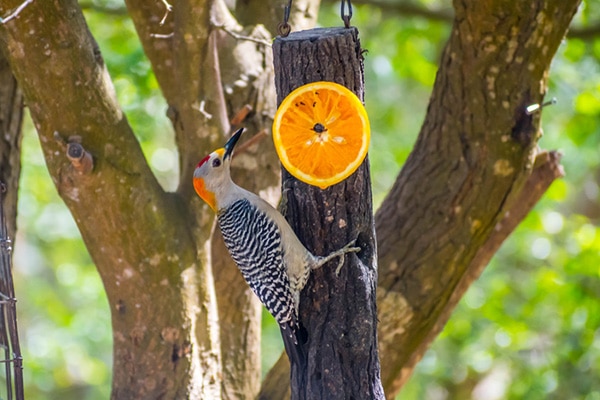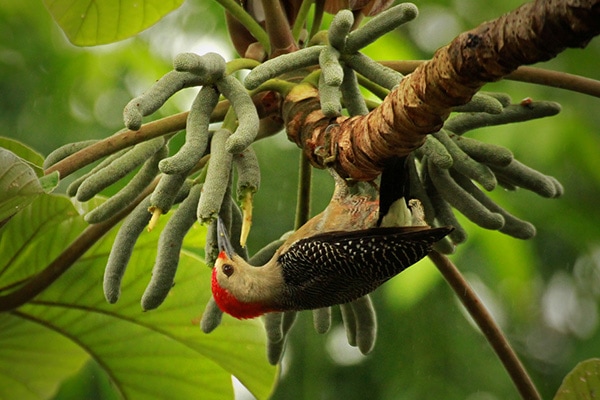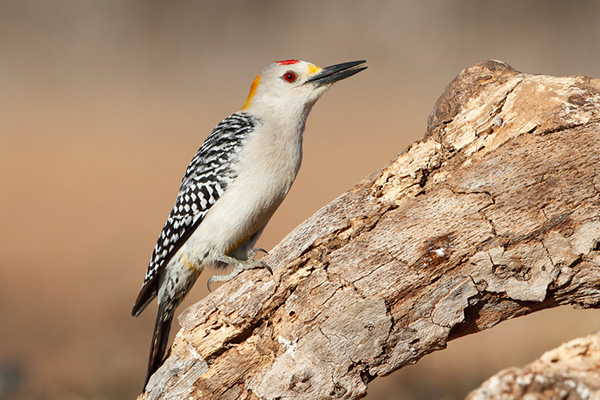Contents
- Golden-fronted woodpecker facts
- Golden-fronted woodpecker: how-to identify
- Where You’ll See Golden-fronted Woodpeckers
- Golden-fronted woodpecker diet
- Golden-fronted woodpecker nesting
- Golden-fronted woodpecker behavior
- How-to attract golden-fronted woodpeckers
- Golden-fronted woodpecker threats
- Golden-fronted woodpecker fun & interesting facts
- Golden-fronted woodpecker related species in this family
Golden-fronted Woodpeckers are North American woodpeckers commonly found in open woodlands. They look very similar to Red-bellied Woodpeckers, but what makes them distinct is their golden forehead, where their name came from.
In this article, we will learn more about the Golden-fronted Woodpecker. We’ll discuss:
- How to identify them
- Where you’ll find them
- What they eat
- How they nest
- Their behaviors
- How to attract them
- Their conservation status
- Interesting facts
So if you want to learn more about these birds, read on as we go through all bird facts…

Golden-fronted woodpecker facts
- Common Name: Golden fronted Woodpecker
- Scientific Name: Melanerpes aurifrons
- Scientific Family: Picidae
- Life Span: 5.7 years
- Size: 8.7 to 10.2 inches
- Wingspan: 16.5 to 17.3 inches
- Weight: 2.6 to 3.5 oz
- Conservation status: Least Concern (LC)
Golden-fronted woodpecker: how-to identify
Golde-fronted Woodpeckers are very similar to Red-bellied Woodpeckers. These birds are medium-sized, generally smaller than the Northern Flicker. They grow at 8.7 to 10.2 inches, weigh around 2.6 to 3.5 ounces, and have a wingspan of 16.5 to 17.3 inches.
These birds feature a black-and-white back and wings, white rump, and black tail. And as their name implies, they feature a yellow-orange nape, a red cap, and a small golden patch sprinkled right at the top of their mandible. Their faces are grayish-colored, and their underparts are gray-white.
Differences Between Male & Female
Male and female Golden-fronted Woodpeckers look very much alike, except for the red cap and yellow spot that only the male birds have. Added to this, if you take a closer look at the lower belly of the female bird, you’ll notice a yellowish plumage. Unfortunately, depending on the angle, this can be difficult to see.
Differences In Summer Plumage vs Winter Plumage
Golden-fronted Woodpeckers look the same all year round, regardless of the season.
Where You’ll See Golden-fronted Woodpeckers
Golden-fronted Woodpeckers are widespread in the Nearctic Region, mainly crossing the border of Southern Texas reaching eastern Mexico.
These birds occupy a wide range of habitats, but most are mainly found in dry, semi-open woodlands where cottonwood, willow, and cypress stand. They can also be found in brushlands where oak and juniper trees grow.
Golden-fronted woodpecker bird migration
Golden-fronted Woodpeckers are non-migratory birds. This means that they stay in their own territories all year round.
Golden-fronted woodpecker diet
Golden-fronted Woodpeckers are omnivorous birds, meaning they can eat almost anything, including insects, fruits, and nuts. Other things included in their diet are beetles, ants, grasshoppers, moths, small lizards, and sometimes, birds’ eggs.
Depending on the area, their diet can change, too. For example, Texas would generally eat acorns, fruits, and berries.
These birds search for insects on tree trunks and limbs, oftentimes picking the food out instead of excavating. In winter, they feed on the ground rather than trees.
Golden-fronted woodpeckers are also frequent backyard visitors. So having some fruit-bearing or nut-bearing trees around would help encourage them to come, especially in winter when there is limited food resource.

Golden-fronted woodpecker nesting
- Clutch Size: 4-7 eggs
- # of Broods: 1-2 broods
- Incubation Period: 12-14 days
- Nestling Period: 30-32 days
- Egg Description: White
Golden-fronted Woodpeckers build their nests in a tree trunk cavity, regardless of whether it’s alive or dead.
These birds would choose nest sites 6-20 feet above ground where both birds would excavate a cavity. Oftentimes, they will choose mesquite, pecan, oak, cottonwood, or cedar elm trees as a nest site. If there are no trees, they might also nest in utility poles and fence posts.
A Golden-fronted Woodpecker’s nest cavity often measures 12.5 inches deep and with an entrance hole that measures 2 inches in diameter. They would then line the bottom of these cavities with wood chips.
Both male and female birds care for their young, with the male and female birds taking turns in the mornings and night.
Golden-fronted woodpecker behavior
Golden-fronted Woodpeckers are monogamous birds that stay together all year round. There is really no specific time of the year when courtship takes place, but pairs are said to bond around late February.
These birds love hopping along flat surfaces and in straight lines, and they love bathing in small bodies of water. So having those small puddles in your backyard might help attract them.
They may not be that aggressive for social birds, but they can be territorial. During the breeding season, they become attack their intruders by expanding their heads fully and lunging directly to their enemy.
Another thing recorded about this bird is that they are forming hybrids with Red-bellied Woodpeckers. Both birds may not be overlapping territories, but somehow this is made possible.
How-to attract golden-fronted woodpeckers
If you want to attract Golden-fronted Woodpeckers, you need to think about what they eat, where they nest, and other things they love.
These birds feed on a wide variety of insects, so making your backyard more insect-friendly would help attract them. They also eat nuts, berries, fruits, and seeds, which means planting some fruit-bearing and nut-bearing plants would help, too. Make sure you hang some bird feeders around filled with their favorite seeds to convince them to hang out.
Provide a place for them to perch and next, too. If there are dead trees and you think it’s safe to keep them standing, don’t cut them.
You should also make sure that they are provided with water. And since these are resident birds, they can visit your backyard in winter. This means that using a heated birdbath would keep providing them with the water they need during the cold season.
Golden-fronted woodpecker threats
Golden-fronted Woodpeckers are part of the low concern list despite their populations slightly declining. They adapt well to the changing of habitats, which is what’s helping them keep their populations stable.
Golden-fronted woodpecker fun & interesting facts
- Unlike most woodpeckers, Golden-fronted woodpeckers eat as much fruit and nuts as insects.
- It comprises four subspecies that differ in size, amount of bars on the tail, nape color, nasal tufts, and belly.
- They were first described by Johann Georg Wagler.
- The oldest recorded Golden-fronted woodpecker lived for 5 years and 11 months old.
- Williamson’s Sapsucker
- Yellow-bellied Sapsucker
- Red-naped Sapsucker
- Red-breasted Sapsucker
- Lewis’s Woodpecker
- Acron Woodpecker
- Gila Woodpecker
- Red-headed Woodpecker
- Red-bellied Woodpecker
- American Three-toed Woodpecker
- Black-beaded Woodpecker
- Downy Woodpecker
- Nuttall’s Woodpecker
- Ladder-backed Woodpecker
- Red-cockaded Woodpecker
- Hairy Woodpecker
- White-headed Woodpecker
- Arizona Woodpecker
- Ivory-billed Woodpecker
- Pileated Woodpecker
- Northern Flicker
- Gilded Flicker

